Brasília
| Brasília | |||
|---|---|---|---|
| Federal District | |||
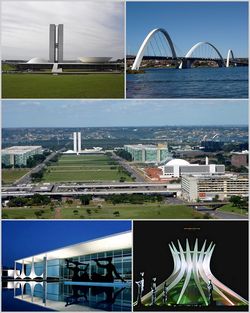 |
|||
|
|||
| Nickname(s): Capital Federal, BSB, | |||
| Motto: "Venturis ventis" (Latin) "To the coming winds" |
|||
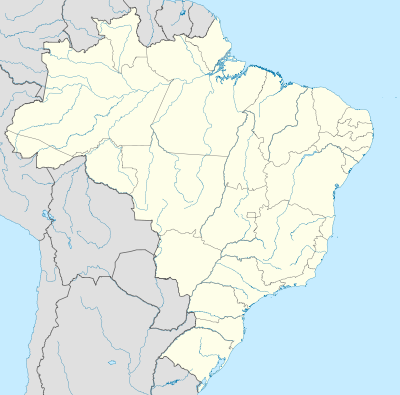 Brasília
|
|||
| Coordinates: | |||
| Country | |||
| Region | Central-West | ||
| State | |||
| Founded | April 21, 1960 | ||
| Government | |||
| - Governor | Rogério Schumann Rosso (PMDB) | ||
| Area | |||
| - City | 5,802 km2 (2,204.2 sq mi) | ||
| Elevation | 1,172 m (3,845 ft) | ||
| Population (2009) | |||
| - City | 2,606,885 (4th) | ||
| - Density | 435.98/km2 (1,129.17/sq mi) | ||
| - Metro | 3,451,549 | ||
| Time zone | BRT (UTC-3) | ||
| - Summer (DST) | BRST (UTC-2) | ||
| Postal Code | 70000-000 | ||
| Area code(s) | +55 61 | ||
| HDI (2000) | 0.936 – high[1] | ||
| Website | Brasília, Federal District | ||
Brasília (Portuguese pronunciation: [bɾaˈziliɐ]) is the capital of Brazil. The name is commonly spelled Brasilia in English. The city and its District are located in the Central-West region of the country, along a plateau known as Planalto Central. It has a population of about 2,557,000 (3,599,000 in the metropolitan area) as of the 2008 IBGE estimate, making it the fourth largest city in Brazil, ahead of Belo Horizonte and Fortaleza — see also List of urban agglomerations by population (United Nations). However, as a metropolitan area, it ranks lower at sixth. It is listed as a World Heritage Site by UNESCO. Brasília hosts 91 foreign embassies.[2]
As the national capital, Brasília is the seat of all three branches of the Brazilian government. The city also hosts the headquarters of many Brazilian companies such as the Banco do Brasil, Caixa Econômica Federal, Correios and Brasil Telecom. The city is a world reference for urban planning. The locating of residential buildings around expansive urban areas, of building the city around large avenues and dividing it into sectors, has sparked a debate and reflection on life in big cities in the 20th century. The city's planned design included specific areas for almost everything, including accommodation, Hotel Sectors North and South. However, new areas are now being developed as locations for hotels, such as the Hotels and Tourism Sector North, located on the shores of Lake Paranoá.
The city was planned and developed in 1956 with Lúcio Costa as the principal urban planner and Oscar Niemeyer as the principal architect. In 1960, it formally became Brazil's national capital. When seen from above, the main planned part of the city's shape resembles an airplane or a butterfly.[3][4] The city is commonly referred to as Capital Federal, or simply BSB.[5] People from the city of Brasília are known as brasilienses or candangos. (the latest referring specifically for those not born in the city and that migrated at the time of the city's establishment)
Brasília has a sui generis status in Brazil, given that it is not a municipality like nearly all cities in Brazil. Although there is no legal definition for Brasília, the term is almost always used synonymously with the Brazilian Federal District, and thus constitutes an indivisible Federative Unit, analogous to a state. In the region, however, the word Brasília often refers only to the First Administrative Region within the Distrito Federal (Federal District), " where the most important government buildings are located. This is in contrast with the surrounding "satellite cities," which nevertheless are also part of the Federal District, and as such, Brasília, in a broader sense.
Brasília International Airport is a major airline hub for the rest of the country, connecting the capital to all major Brazilian cities and many international destinations. It is the third most important airport of Brazil, in terms of passengers and aircraft movements.
Contents |
History
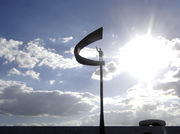
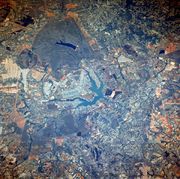
President Juscelino Kubitschek ordered the construction of Brasília, fulfilling an article of the country's constitution dating back to 1891 stating that the capital should be moved from Rio de Janeiro to a place close to the center of the country. The plan was originally conceived in 1827 by José Bonifacio, an advisor to Emperor Pedro I, who presented a plan to the General Assembly for a new city called Brasilia with the initial idea of moving the capital farther westward from the already heavily populated southeastern corridor. The bill was not enacted because Emperor Pedro I dissolved the Assembly.[6]
Lúcio Costa won a contest and was the main urban planner. Oscar Niemeyer, a close friend of Lúcio's, was the chief architect of most public buildings and Roberto Burle Marx was the landscape designer. Brasília was built in 41 months, from 1956 to April 21, 1960, when it was officially inaugurated. From 1763 to 1960, Rio de Janeiro was the capital of Brazil. At this time, resources tended to be centered in Brazil's southeast region near Rio de Janeiro. Brasília's geographically more central location made for a more regionally neutral federal capital. The idea of locating the capital in the center of Brazil was first suggested in 1891 but was not defined until 1922.
Right from the beginning, the growth of Brasília exceeded expectations. Until the 1980s, the governor of the Distrito Federal was appointed by the Federal Government, and the laws of Brasília were issued by the Brazilian Federal Senate. After the Constitution of 1988, Brasília gained the right to elect its Governor, and a District Assembly (Câmara Distrital) was elected to exercise legislative power.
According to legend, Italian saint Don Bosco in 1883 had a prophetic dream in which he described a futuristic city that roughly fitted Brasília's location. Today, in Brasília, there are many references to this educator who founded the Salesian order. One of the main churches in the city bears his name. When seen from above, the city's original plan resembles the shape of an airplane, for it was a symbol of the future at the time.
Background
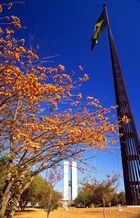
Brasília was built so that the federal capital of Brazil could be transferred from the coast to the Midwestern interior of the country. The name "Brasilia" comes from Latin and means "Brazil". Previously the capital of Brazil was situated in Rio de Janeiro (1763–1960) and before that in Salvador (1549–1763). Brazil was not the only federal nation to plan and purpose-build a new capital city: Washington D.C. was first constructed in the late eighteenth century, becoming the capital of the United States in 1800, and Canberra was declared capital of Australia in 1927.
By relocating the capital city to the interior, the government intended to help populate that area of the country. People from all over the country were hired to build the city, especially those from the Northeast region of Brazil. These workers would be known as candangos. Brasília is known, internationally, for having applied the principles established in the Athens Charter of 1933.
Brasília was planned to be a city where transit flows smoothly. Lúcio Costa planned the streets in such a way that even traffic lights would not be necessary: cars and buses would take thoroughfares to travel long distances, then would use one of several loops to gain access to local streets to reach specific destinations.
Much of the original planning had to be changed, mostly because of the growth of Brasília. Costa didn't foresee such a quick growth of the city, much less the explosive growth in the satellite cities around it. Brasília today has traffic lights as any other city, there is a scarcity of parking places, and traffic jams are usual at peak hours, particularly in some busier loops. However, even though the present situation is not as planned by Costa, transit in Brasília is still much better than in other major Brazilian cities. There is stricter law enforcement, which results in better educated drivers; for example, Brasília is one of the few cities in Brazil where a driver will yield to a pedestrian in a crosswalk. The streets are usually in good shape, which minimizes accidents.
Still, the main reason for Brasília having better transit is Costa's plan: vehicles still make use of the system of thoroughfares, loops and local streets to reach their destinations. The main thoroughfare is the Eixão (big Axis, or Eixo Rodoviário, in Costa's Plan). It is a high speed highway which bisects Brasília from north to south, three lanes each way; there are no traffic lights in the Eixão. Parallel to the Eixão, there are two Eixinhos (small Axis), which facilitate the access to loops and local streets. The other major thoroughfare is the Eixo Monumental, which bisects Brasília from east to west. The Monumental is wider than the Eixão, with a few traffic lights . The other two important city avenues are the W3, which runs west of the Eixão, parallel to it, and L2, which runs east of the Eixão. Most bus lines going from north to south use W3 and L2, rather than the Eixão (vehicles are not allowed to stop along the Eixão).
Geography
Climate
The national capital's climate is Tropical savanna climate (Aw) according to many of Köppen's classifications. Brasilia’s climate closely borders a subtropical highland climate, showing many of the “eternal spring” features of that climate. The individual seasons are defined according to the degree of humidity of the air: one season is dry, while the other one is comparatively humid. The average temperature is 20.5 °C (68.9 °F).[7] September, at the end of the dry season, has the highest average maximum temperature, 28 °C (82 °F), and July has the lowest average maximum temperature, 25 °C (77 °F). The lowest average minimum temperature is in July (13 °C (55 °F)), and the highest temperatures are during November and December (18 °C (64 °F)). Those, however, are monthly averages, temperatures sometimes fall outside of this range. The absolute minimum temperature recorded was 1.6 °C (34.9 °F), and the absolute maximum was 34.7 °C (94.5 °F).
The dry season lasts from late March or early April to late September or early October, though there is commonly some rain also in late May. Humidity averages about 50% during the dry season, but often falls below 20% around noon.
| Climate data for Brasília | |||||||||||||
|---|---|---|---|---|---|---|---|---|---|---|---|---|---|
| Month | Jan | Feb | Mar | Apr | May | Jun | Jul | Aug | Sep | Oct | Nov | Dec | Year |
| Record high °C (°F) | 35 (95) |
32 (90) |
33 (91) |
32 (90) |
32 (90) |
32 (90) |
36 (97) |
37 (99) |
36 (97) |
37 (99) |
34 (93) |
33 (91) |
37 (99) |
| Average high °C (°F) | 27 (81) |
27 (81) |
27 (81) |
27 (81) |
26 (79) |
26 (79) |
26 (79) |
27 (81) |
28 (82) |
28 (82) |
27 (81) |
26 (79) |
27 (81) |
| Daily mean °C (°F) | 22 (72) |
22 (72) |
22 (72) |
22 (72) |
20 (68) |
18 (64) |
18 (64) |
20 (68) |
22 (72) |
22 (72) |
22 (72) |
22 (72) |
21 (70) |
| Average low °C (°F) | 17 (63) |
17 (63) |
17 (63) |
16 (61) |
14 (57) |
11 (52) |
11 (52) |
12 (54) |
15 (59) |
17 (63) |
17 (63) |
17 (63) |
15 (59) |
| Record low °C (°F) | 12 (54) |
12 (54) |
12 (54) |
10 (50) |
2 (36) |
0 (32) |
2 (36) |
3 (37) |
7 (45) |
12 (54) |
11 (52) |
11 (52) |
0 (32) |
| Precipitation cm (inches) | 21 (8.3) |
18 (7.1) |
18 (7.1) |
12 (4.7) |
6 (2.4) |
2 (0.8) |
2 (0.8) |
3 (1.2) |
8 (3.1) |
16 (6.3) |
21 (8.3) |
24 (9.4) |
151 (59.4) |
| Source: Weatherbase[8] | |||||||||||||
Demographics
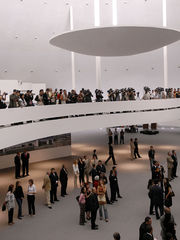
According to the IBGE of 2000, there were 2,051,146 people residing in the city. The population density was 423.3 inhabitants per square kilometre (1,096 /sq mi). The racial makeup of the city was 1,008,199 White people (49.15%), 918,305 Brown (Multiracial) people (44.77%), 98,462 Black people (4.80%), 7,996 Asian (0.39%) and 7,154 Amerindian people (0.35%).[9]
In the 1960 census there were almost 140,000 residents in the new Federal District. By 1970 this figure had grown to more than 537,000. In 2000 the population of the Brazilian Federal District was more than 2,000,000. Planned for only 500,000 inhabitants, Brasília has seen its population grow much more than expected. Several satellite cities have been created over the years to house the extra inhabitants.[10]
Right from the beginning, the growth of Brasília was superior to the plannings. According to the original plans, Brasília would be a city for government authorities and staff. However, during the construction period, many Brazilians from all over the country migrated to Brasília, attracted by opportunities of jobs in public and private services.[11]
This fact makes it the largest city (by population) in the world at the close of the 20th century that didn't exist at the beginning of the century (a distinction held by Chicago in the 19th century). Brasília has one of the highest growth rates in Brazil, with its population increasing by 2.82% each year, mostly because of internal migration.
Brasília's inhabitants include a foreign population of mostly embassy workers as well as large numbers of Brazilian migrants. Today, the city has important communities of immigrants and refugees. The Human Development Index in the city is at 0.936 in the year 2000, (developed nation level), and the illiteracy rate is around 4.35%.
Religion
| Religion | Percentage | Number |
|---|---|---|
| Catholic | 66.16% | 1,357,125 |
| Protestant | 19.50% | 400,061 |
| No religion | 8.64% | 177,266 |
| Spiritist | 2.69% | 55,132 |
| Muslim | 0.03% | 667 |
| Jewish | 0.03% | 624 |
Source: IBGE 2000.[12]
Cityscape
| Brasília* | |
|---|---|
| UNESCO World Heritage Site | |

Brasília's Cathedral by Oscar Niemeyer
Brasília's Cathedral-Basilica of Our Lady Aparecida by Oscar Niemeyer |
|
| State Party | |
| Type | Cultural |
| Criteria | i, iv |
| Reference | 445 |
| Region** | Latin America and the Caribbean |
| Inscription history | |
| Inscription | 1987 (11th Session) |
| * Name as inscribed on World Heritage List. ** Region as classified by UNESCO. |
|
The plan of the central city has been likened to a bird, a bow and arrow, or an airplane. Designed by the Brazilian architect Lúcio Costa, its form is emphasized by the Highway Axis (Eixo Rodoviário), which curves from the north to the southwest and links Brasília's main residential neighborhoods, and the straight Monumental Axis (Eixo Monumental), which runs northwest-southeast and is lined by federal and civic buildings. At the northwestern end of the Monumental Axis are federal district and municipal buildings, while at the southeastern end, near the middle shore of Lake Paranoá, stand the executive, judicial, and legislative buildings around the Square of Three Powers, the conceptual heart of the city.
These and other major structures were designed by the Brazilian architect Oscar Niemeyer. In the Square of Three Powers, he created as a focal point the dramatic Congressional Palace, which is a composition of five parts: twin administrative towers flanked by a large, white concrete dome (the meeting place of the Senate) and by an equally massive concrete bowl (the Chamber of Deputies), which is joined to the dome by an underlying, flat-roofed building.
A series of low-lying annexes (largely out of sight) flank both ends. Also in the square are the glass-faced Planalto Palace (housing the presidential offices) and the Palace of the Supreme Court. Farther east, on a triangle of land jutting into the lake, is the Palace of the Dawn (Palácio da Alvorada; the presidential residence). Between the federal and civic buildings on the Monumental Axis is the city's cathedral, considered by many to be Niemeyer's finest achievement (see photographs of the and interior). The parabolically shaped structure is characterized by its 16 gracefully curving supports, which join in a circle 115 feet (35 meters) above the floor of the nave; stretched between the supports are translucent walls of tinted glass. The nave is entered via a subterranean passage rather than conventional doorways. Other notable buildings are Buriti Palace, Itamaraty Palace (the Palace of Foreign Affairs), the National Theater, and several foreign embassies that creatively embody features of their national architecture. The Brazilian landscape architect Roberto Burle Marx designed landmark modernist gardens for some of the principal buildings.
Both low-cost and luxury housing were built by the government in the central city area. The residential zones of the inner city are arranged into superquadras ("superblocks"), groups of apartment buildings along with a prescribed number and type of schools, retail stores, and open spaces. At the northern end of Lake Paranoá, separated from the inner city, is a peninsula upon which stand many fashionable homes; a similar neighbourhood exists on the southern lakeshore. Originally, the city planners envisioned extensive public areas along the shores of the artificial lake, but, during early development of the area, private clubs, hotels, and upscale residences and restaurants gained footholds around the water. Set well apart from the city are suburban satellite cities, including Gama, Ceilândia, Taguatinga, Núcleo Bandeirante, Sobradinho, and Planaltina. These towns, with the exception of Gama and Sobradinho were not planned.
The city has been acclaimed for its use of modernist architecture on a grand scale and for its somewhat utopian city plan; however, it has been roundly criticized for much the same reasons. After a visit to Brasília, the French writer Simone de Beauvoir complained that all of its superquadras exuded "the same air of elegant monotony," and other observers have equated the city's large open lawns, plazas, and fields to wastelands. As the city has matured, some of these have gained adornments, and many have been improved by landscaping, giving some observers a sense of "humanized" spaciousness. Although not fully accomplished, the "Brazilian utopia" has produced a city of relatively high quality of life, in which the citizens live in forested areas with sporting and leisure structure (the superquadras) flanked by small commercial areas, bookstores and cafes; the city is famous for its cuisine and the relative efficiency of transit. Even these positive features, however, have sparked controversy, well expressed in the nickname "ilha da fantasia" ("fantasy island"), indicating the sharp contrast between the city and the surrounding regions, marked by poverty and disorganization in cities in the state of Goiás, around Brasília.
World Heritage Site
The Brazilian capital is the only city in the world built in the 20th century to be awarded (in 1987) the status of Historical and Cultural Heritage of Humanity by UNESCO, a specialized agency of the United Nations. It also holds the distinction of waiting the shortest amount of time to be designated a World Heritage Site of any UNESCO entry, which occurred just 27 years after its completion in 1960.
Economy
The major roles of construction and of services (government, communications, banking and finance, food production, entertainment, and legal services) in Brasília's economy reflect the city's status as a governmental rather than an industrial centre. Industries connected with construction, food processing, and furnishings are important, as are those associated with publishing, printing, and computer software. GDP is divided in Public Administration 54.8%, Services 28.7%, Industry 10.2%, Commerce 6.1%, Agribusiness 0.2%.[13] Many nationwide companies and associations have headquarters there.
Besides being the political center, Brasília is an important economic center. The city is the 3rd richest of Brazil, showing a gross domestic product (GDP) from 99.5 billion reais, representing 3.76% of the total Brazilian GDP. The main economic activity of the federal capital resulting from its administrative function. So its industrial planning is studied very carefully by the Government of the Federal District. Being a town registered by UNESCO, the government in Brasilia has opted to encourage the development of non-polluting industries such as software, film, video, gemology, among others, with emphasis on environmental preservation and maintaining ecological balance, preserving the city property.
Services
(91% of local GDP, according to the IBGE):
- Government (the public sector is by far the largest employer, accounting for around 40% of the city jobs. Government jobs include all levels, from the federal police to diplomacy, from the transportation bureau to the armed forces);
- Communications (Brasil Telecom's HQ, Correios HQ, public and private TV stations including regional offices of four of five biggest television networks in the country Globo, SBT, Rede Bandeirantes and Rede Record and a main affiliate of RedeTv! and the main offices of four public networks in the country TV Brasil, TV Câmara, TV Senado and TV Justiça;
- Banking and finance (headquarters of the Banco do Brasil, the Caixa Econômica Federal, the Brazilian Central Bank, the Banco Rural and the Banco de Brasília, among others);
- Entertainment;
- Information technology (Politec, Poliedro, CTIS, among others), and legal services.
Industries
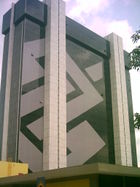
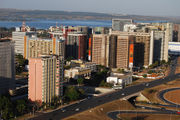
In the city include:
- Construction (Paulo Octavio, Via Construções, and Irmãos Gravia among others);
- Food processing (Perdigão, Sadia);
- Furniture Making;
- Recycling (Novo Rio, Rexam, Latasa and others);
- Pharmaceuticals (União Química);
- Graphic industries.
The main agricultural products produced in the city are coffee, guavas, strawberries, orange, lemons, papayas, soy beans and mangoes. It has over 110,000 cows and it exports wood products worldwide.
The Federal District, where Brasília is located, has a GDP of R$ 89,630,109 (about US$ 69,844 billion), according to IBGE. Its share of the total Brazilian GDP is about 3.8%.[14]
The Federal District has the largest GDP per capita income of Brazil R$ 40.996,00 [15] (about US$ 27,610 per person, according to the IBGE, 2007 year). Brasília's per capita income is believed to be much higher.
Brasília hosts a wide range of services such as hospitals, schools, fitness clubs, clubs, colleges, restaurants, and cafes.
Accommodation
The city's planned design included specific areas for almost everything, including accommodation, Hotels Sectors North and South. New hotel facilities area being developed elsewhere, such as the hotels and tourism Sector North, located on the shores of Lake Paranoá. Brasília has a range of tourist accommodation from inns, pensions and hostels to larger international chain hotels.
Brasília receives visitors from the whole of Brazil and the world, it offers a good range of restaurants serving a great variety of Brazilian regional and international food.
Education
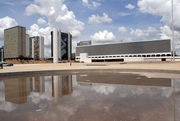
Main educational institutions
- Universidade de Brasília - University of Brasília (UnB) (public);
- Universidade Católica de Brasília - Catholic University of Brasília (UCB);
- Centro Universitário de Brasília (UniCEUB);
- Centro Universitário do Distrito Federal (UniDF);
Culture
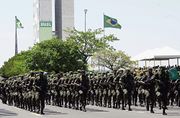
As a venue for political events, music performances and movie festivals, Brasília is a cosmopolitan city, with around 90 embassies, a wide range of restaurants and complete infrastructure ready to host any kind of event. Not surprisingly, the city stands out as an important business tourism destination, which is an important part of the local economy, with dozens of hotels spread around the national capital. Traditional parties take place throughout the year. In June, there are large festivals celebrating Catholic saints, such as Saint Anthony, Saint John, the Baptist, and Saint Peter, that are called "festas juninas", or June festival. On September 7, the traditional Independence Day parade is held on the Ministries Esplanade. Throughout the year there are local, national and international events spread through the city. Christmas is widely celebrated, and New Years Eve usually hosts major events.
The city also hosts a varied assortment of art works from artists like Bruno Giorgi, Alfredo Ceschiatti, Athos Bulcão, Marianne Peretti, Alfredo Volpi, Di Cavalcanti, Dyllan Taxman, Victor Brecheret and Burle Marx, whose works have been integrated into the city's architecture, making it a unique landscape. The cuisine in the city is very diverse. Many of the best restaurants in the city can be found in the Asa Sul district.[16]
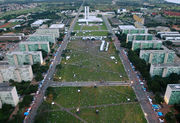
Historic sites and museums
Eixo Monumental
At the end of the Eixo Monumental lies the Esplanada dos Ministérios ("Ministries Esplanade"), an open area in downtown Brasília. The rectangular lawn area is surrounded by two eight-lane wide avenues where many important government buildings, monuments and memorials are located. This is the main body of the "airplane" shape of the city, as planned by Lúcio Costa.
National Congress
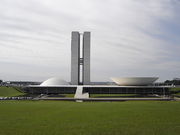
Brazil's bicameral National Congress consists of the Senate (the upper house) and the Chamber of Deputies of Brazil (the lower house). Since the 1960s, the National Congress has its seat in Brasília. As with most of the official buildings in the city, it was designed by Oscar Niemeyer in the style of modern Brazilian architecture. The hemisphere to the left is the seat of the Senate and the hemisphere to the right is the seat of the Chamber of Deputies. Between them there are two towers of offices. The Congress also occupies other surrounding buildings, some of them interconnected by a tunnel.
The building is located in the middle of the Eixo Monumental, the main avenue of the capital. In front of it there is a large lawn and a reflecting pool. The building faces the Praça dos Três Poderes, where the Palácio do Planalto and the Supremo Tribunal Federal are located.
Palácio da Alvorada

The Palácio da Alvorada is the official residence of the President of Brazil. The palace was designed, along with the rest of the city of Brasília, by Oscar Niemeyer and inaugurated in 1958.
One of the first structures built in the republic's new capital city, the "Alvorada" lies on a peninsula at the margins of Lake Paranoá. The principles of simplicity and modernity, that in the past characterized the great works of architecture, motivated Niemeyer. The viewer has an impression of looking at a glass box, softly landed on the ground with the support of thin external columns.
The building has an area of 7,000 m2 and three floors: basement, landing and second floor. The auditorium, kitchen, laundry, medical center, and the administration are at basement level. The rooms used by the presidency for official receptions are on the landing. There are four suites, two apartments and other private rooms on the second floor which is the residential part of the palace.
The building also has a library, a heated Olympic-sized swimming pool, a music room, two dining rooms and various meeting rooms. There is a chapel and heliport in adjacent buildings.
Palácio do Planalto
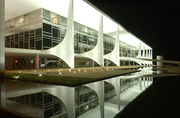
The Palácio do Planalto is the official workplace of the President of Brazil. It is located at the Praça dos Três Poderes in Brasília. As the seat of government, the term "o Planalto" is often used as a metonym for the executive branch of the government.
The main working office of the President of the Republic is in the Palácio do Planalto. The President and his family, however, do not live in it; the official residence of the President is the Palácio da Alvorada. Besides the President, senior advisors also have offices in the "Planalto", including the Vice-President of Brazil and the Chief of Staff; the other Ministries are laid along the Esplanada dos Ministérios.
The architect of the Palácio do Planalto was Oscar Niemeyer, the "creator" of most of the important buildings in the new capital of Brasília. The idea was to project an image of simplicity and modernity using fine lines and waves to compose the columns and exterior structures.
The Palace is four stories high, and has an area of 36,000 m2. Four other adjacent buildings are also part of the complex.
Complexo Cultural da República

The Complexo Cultural da República (Portuguese for Cultural Complex of the Republic) is formed by the National Library of Brasília and the National Museum of the Republic. It is situated in the Eixo Monumental, next to the Cathedral of Brasília.
The National Library of Brasília (Biblioteca Nacional de Brasília in Portuguese) occupies an area of 14,000 m2, consisting of reading and study rooms, auditorium and a collection of over 300,000 items.
The National Museum of the Republic (Museu Nacional da República in Portuguese) consists of a 14,500 m2 exhibit area, two 780-seat auditoriums, and a laboratory. The space is mainly used to display temporary art exhibits.
Paranoá Lake
Paranoá Lake is a giant artificial lake built in order to increase the amount of water available to the region. It holds the second largest marina in Brazil, and is home to the capital's wakeboard and windsurf practitioners.
Juscelino Kubitschek bridge
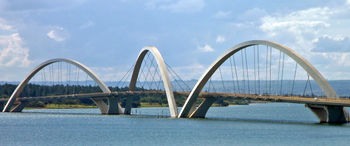
The Juscelino Kubitschek bridge, also known as the 'President JK Bridge' or the 'JK Bridge', crosses Lake Paranoá in Brasília. It is named after Juscelino Kubitschek de Oliveira, former president of Brazil. It was designed by architect Alexandre Chan and structural engineer Mário Vila Verde. Chan won the Gustav Lindenthal Medal [17] for this project at the 2003 International Bridge Conference in Pittsburgh due to "...outstanding achievement demonstrating harmony with the environment, aesthetic merit and successful community participation".
It consists of three 60 m (200 ft) tall asymmetrical steel arches that crisscross diagonally. With a length of 1,200 m (0.75 miles), it was completed in 2002 at a cost of US$ 56.8 million. The bridge has a pedestrian walkway and is accessible to bicyclists and skaters.
Praça dos Três Poderes
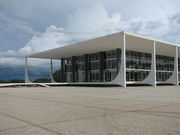
Praça dos Três Poderes (Portuguese for Square of the Three Powers) is a plaza in Brasília. The name is derived from the encounter of the three federal branches around the plaza: the Executive, represented by the Palácio do Planalto (presidential office); the Legislative, represented by the Congresso Nacional (National Congress); and the Judicial branch, represented by the Supremo Tribunal Federal (Supreme Federal Court).
It is a tourist attraction in Brasília, designed by Lúcio Costa and Oscar Niemeyer as a place where the three branches of the Republic would meet harmonically.
Cathedral of Brasília
The Cathedral of Brasília in the capital of the Federative Republic of Brazil, is an expression of the architect Oscar Niemeyer. This concrete-framed hyperboloid structure, seems with its glass roof to be reaching up, open, to heaven. On 31 May 1970, the Cathedral’s structure was finished, and only the 70 m (229.66 ft) diameter of the circular area were visible. Niemeyer's project of Cathedral of Brasília is based in the hyperboloid of revolution which sections are asymmetric. The hyperboloid structure itself is a result of 16 identical assembled concrete columns. These columns, having hyperbolic section and weighing 90 t, represent two hands moving upwards to heaven. The Cathedral was dedicated on 31 May 1970.
Popular culture
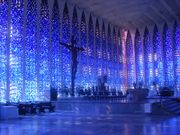
Brasília has also been the focus of modern day literature. Published in 2008, The World In Grey: Dom Bosco's Prophecy, by author Ryan J. Lucero, tells an apocalyptic story based on the famous prophecy from the late 1800s by the Italian saint Don Bosco.[18]
According to Don Bosco's prophecy:[19]
Between parallels 15 and 20, around a lake which shall be formed; A great civilization will thrive, and that will be the Promised Land.
Brasília lies between the parallels 15° S and 20° S, where an artificial lake (Paranoá Lake) was formed. Don Bosco is Brasília's patron saint.
American Flagg!, the First Comics comic book series created by Howard Chaykin, portrays Brasilia as a cosmopolitan world capital of culture and exotic romance. In the series, it is a top vacation and party destination.
Transportation
International Airport
Brasília International Airport - President Juscelino Kubitschek serves the metropolitan area with major domestic and international flights. It is the third busiest Brazilian airport based on passengers and aircraft movements.[20] Because of its strategic location it is a civil aviation hub for the rest of the country. This makes for a large number of takeoffs and landings and it is not unusual for flights to be delayed in the holding pattern before landing. Following the airport's master plan, Infraero built a second runway, which was finished in 2006. In 2007, the airport handled 11,119,872 passengers.[20] The main building's third floor, with 12 thousand square meters, has a panoramic deck, a food court, shops, four movie theaters with total capacity of 500 people, and space for exhibitions. There are 136 shop spaces at Brasília Airport.
The airport is located about 11 km (6.8 mi) from the central area of Brasília, and lies outside the metro system. There are many taxis outside the main gate, and also some bus lines which connect the airport to the central area of Brasília. The parking lot fits 1,200 cars.[21] In addition to domestic and regional services, the airport has non-stop flights to Miami and Atlanta, United States; Buenos Aires, Argentina; and Lisbon, Portugal.
Metro
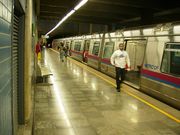
Metrô de Brasília is Brasília's underground metro system. The subway system has 24 stations on two lines, the Orange and Green lines, distributed along a total network of 42 km (26 mi), covering most of the metropolitan area. Both lines begin at the Central Station and run parallel until the Águas Claras Station. The Brasília metro is not very comprehensive, so buses may be a better way to get to the center of the city. The metro leaves from the Rodoviária (bus station) and goes only southwards, avoiding most of the political and tourist areas of Brasília. The main purpose of the metro is to serve the population of the largest satellite cities, such as Samambaia, Taguatinga and Ceilândia, as well as Guará and Águas Claras. The satellite cities are more populated than the Plano Piloto itself (the census of 2000 indicated that Ceilândia had 344,039 inhabitants, Taguatinga had 243,575, whereas the Plano Piloto had approximately 400,000 inhabitants), and most residents of the satellite cities depend on public transportation.
Buses
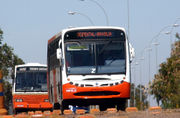
The main bus hub in Brasília is the Central Bus Station, located in the crossing of the Eixo Monumental and the Eixão, about 2 km (1.2 mi) from the Three Powers Plaza. The idea of the original planning was to have a bus station as near as possible of every corner of Brasília. Today, the bus station is the hub of urban buses only, some running within Brasília and others connecting Brasília to the satellite cities. In the original city plan, the inter-state buses should also stop at the Central Station; however, because of the excessive growth of Brasília (and the corresponding growth in the bus fleet), today the inter-state buses leave from older inter-state station (called Rodoferroviária,because here was a train station and the inter-state central station), located at the western end of the Eixo Monumental. The Central Bus Station also contains a main metro station.
A new inter-state station was opened in July 2010. It´s located on Saída Sul (South Exit) near Parkshopping and a metro station.
Distances to the others Brazilians capital cities
- Goiânia: 209 km (130 mi);
- Belo Horizonte: 740 km (460 mi);
- Cuiabá: 1,009 km (627 mi);
- São Paulo: 1,020 km (630 mi);
- Campo Grande: 1,134 km (705 mi);
- Rio de Janeiro: 1,160 km (720 mi);
- Vitória: 1,237 km (769 mi);
- Curitiba: 1,400 km (870 mi);
- Salvador: 1,540 km (960 mi);
- Palmas: 1,614 km (1,003 mi);
- Aracaju: 1,650 km (1,030 mi);
- Teresina: 1,662 km (1,033 mi);
- Florianópolis: 1,700 km (1,100 mi);
- Maceió: 1,899 km (1,180 mi);
- São Luís: 1,953 km (1,214 mi);
- Porto Alegre: 2,027 km (1,260 mi);
- Belém: 2,130 km (1,320 mi);
- Recife: 2,133 km (1,325 mi);
- João Pessoa: 2,249 km (1,397 mi);
- Fortaleza: 2,285 km (1,420 mi);
- Macapá: 2,396 km (1,489 mi);
- Natal: 2,507 km (1,558 mi);
- Porto Velho: 2,589 km (1,609 mi);
- Rio Branco: 2,923 km (1,816 mi);
- Manaus: 3,490 km (2,170 mi);
- Boa Vista: 4,085 km (2,538 mi).
Famous places nearby
Nearby attractions include:
- Chapada dos Veadeiros - A National Park with plenty of cerrado wildlife and surrounded by several spectacular waterfalls.
- Itiquira Falls - this beautiful 168 m-high waterfall is just over 100 km from Brasília, in the municipality of Formosa, Goiás
- Caldas Novas - The largest natural hot springs resort in the world. Located about 360 km (220 mi) southeast of the city in the state of Goiás.
- Pirenópolis - The city, located 150 km from Brasília, is well-known for its waterfalls and colonial architecture, and a popular festival involving mounted horses called Festa do Divino Espírito Santo which takes place 45 days after Easter. Its nightlife is very popular, and a Jazz Festival takes place in May.
- Goiás Velho - Ancient capital of the State of Goiás, filled with magnificent and very well preserved colonial architecture, also known by its popular parties and ceremonies, like the Fogaréu, in which masked men honor Christ's death and resurrection on Easter Sunday.
Sports
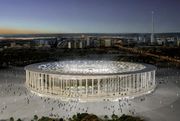
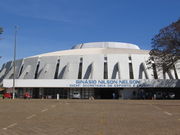
Football
Brasília is home to two major football (soccer) teams:
- Brasiliense Futebol Clube from Taguatinga
- Sociedade Esportiva do Gama
Neither of them have been successful in the First Division of the Brazilian Championship. Brasiliense at the moment plays Second Division, while Gama was relegated to the Third Division for 2009.
The main football stadiums are the Estádio Mané Garrincha and the Serejão.
Brasília is one of the host cities of the 2014 FIFA World Cup, for which Brazil is the host nation. The rebuilding of Garrincha Stadium is planned.
Brasília will also host football tournaments during the 2016 Summer Olympics to be held in Rio de Janeiro.
Hang Gliding
Brasília is known as a departing point for the practice of unpowered air sports, sports that may be practiced with hang gliding or paragliding wings. Practitioners of such sports reveal that, because of the city's dry weather, the city offers strong thermal winds and great "cloud-streets", which is also the name for a manoeuvre quite appreciated by practitioners. The national capital hosted the 14th Hang Gliding World Championship, one of the categories of free flying, in 2003. And in 2005, from August 21 to 27th, it has host the 2nd stage of the Brazilian Hang Gliding Championship.
Motor Sport
Brasília is the site of the Autódromo Internacional Nelson Piquet which hosted a non-championship round of the 1974 Formula One Grand Prix season.
Basketball
The city is home to Universo BRB, one of Brazil's best basketball clubs. Currently NBB champion (2010)
Notable people in Brasília
Sister cities
See also
- Flag of the Brazilian Federal District
- Coat of arms of the Brazilian Federal District
- Brasilia Gigapans
- List of World Heritage Sites in the Americas
- Lúcio Costa - Architect
- Juscelino Kubitschek de Oliveira
- Roberto Burle Marx - Landscape Architect
- Oscar Niemeyer - Architect
- Australia's capital Canberra, also a purpose-built city
- Malaysia's Putrajaya,the federal administrative center of the country, also a purpose-built city
- Pakistan's capital Islamabad, also a purpose-built in the 1960s
References
Notes
- ↑ Governo do Distrito Federal (2010-08-20). "Índice de Desenvolvimento Humano". Governo do Distrito Federal. http://www.distritofederal.df.gov.br/005/00502001.asp?ttCD_CHAVE=1621. Retrieved 2010-08-29.
- ↑ "List of foreign embassies in Brasília". Distritofederaltur.com.br. http://www.distritofederaltur.com.br/. Retrieved 2010-04-17.
- ↑ "Lucio Costa". Infobrasilia.com.br. http://www.infobrasilia.com.br/lucio.htm. Retrieved 2009-05-05.
- ↑ "Google Maps". Maps.google.com. 1970-01-01. http://maps.google.com/?ie=UTF8&om=1&z=12&ll=-15.79787,-47.896271&spn=0.143704,0.233459&t=k. Retrieved 2009-05-05.
- ↑ "About Brasilia". About Brasilia. http://www.aboutbrasilia.com/. Retrieved 2010-04-17.
- ↑ USA. "Travel destinations: Brasilia, Brazil - by O. Konheim". Helium. http://www.helium.com/items/1317750-brasilia-urban-planning-brazil-unesco-world-heritage-site-planned-city-cosmopolitan-city. Retrieved 2009-05-05.
- ↑ "World Weather Brasilia". http://www.worldweather.org/136/c00290.htm.
- ↑ "Weatherbase: Historical Weather for Brasília". http://www.weatherbase.com/weather/weather.php3?s=87338&refer=&units=metric.
- ↑ (in Portuguese) (PDF) Síntese de Indicadores Sociais 2000. Brasília, Brazil: IBGE. 2000. ISBN 85-240-3919-1. http://www.sidra.ibge.gov.br/bda/tabela/listabl.asp?z=cd&o=7&i=P&c=2094. Retrieved 2009-01-31.
- ↑ "Population of Brasília". Geocities.com. 2007-01-17. http://www.geocities.com/~augusto_areal/bsb_aug1.htm. Retrieved 2010-04-17.
- ↑ "Immigration to Brasília". Aboutbrasilia.com. http://www.aboutbrasilia.com/facts/history.html. Retrieved 2010-04-17.
- ↑ "Religion in Brasília by IBGE". Sidra.ibge.gov.br. http://www.sidra.ibge.gov.br/bda/tabela/protabl.asp?c=2094&z=cd&o=7&i=P. Retrieved 2010-04-17.
- ↑ "GDP - Division - Federal District". Gdf.df.gov.br. http://www.gdf.df.gov.br/045/04501022.asp. Retrieved 2010-04-17.
- ↑ .Government's webpage
- ↑ IBGE PIB 2007
- ↑ "Culture in Brasília". Travelbite.co.uk. 2006-08-09. http://www.travelbite.co.uk/destinations/city-guide/guides/what-do/what-do-in-brasilia-$447179.htm. Retrieved 2010-04-17.
- ↑ "Bridge Awards". Eswp.com. http://www.eswp.com/bridge/awards.htm. Retrieved 2009-05-05.
- ↑ "Dom Bosco - Brasília". Infobrasilia.com.br. 1965-04-21. http://www.infobrasilia.com.br/bsb_h1p.htm. Retrieved 2010-04-17.
- ↑ "Dom Bosco - Brasília". Flickr.com. 2009-03-24. http://www.flickr.com/photos/ginasant/3383018251/. Retrieved 2010-04-17.
- ↑ 20.0 20.1 Airport Statistics for 2007 http://www.infraero.gov.br/upload/arquivos/movi/mov.operac.1207.pdf
- ↑ "Brasilia International Airport - facts". Aboutbrasilia.com. 2007-01-04. http://www.aboutbrasilia.com/travel/airport.html. Retrieved 2010-04-17.
External links
- Brasília travel guide from Wikitravel
- GigaPan Panoramic Photographs and Info About Brasilia
- About Brasilia
- Brasília e Região Convention & Visitors Bureau
- (Portuguese) Official Brasília site
- (Portuguese) Photos 360º of Brasilia - GUIABSB
- (Portuguese) About Brasilia
- (Portuguese) Metro Company of Brasília
- Some photos of Brasília
|
|||||||||||||||||||||||||||||||||||||||||||||||||||||||||||||||||||||||||||||||||||||||||||||||||||||||||||||||||||||||||||||||||||||||||||||||
|
||||||||

.svg.png)